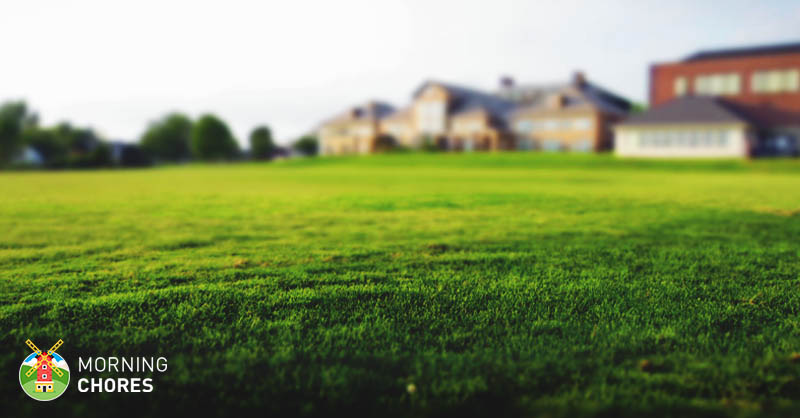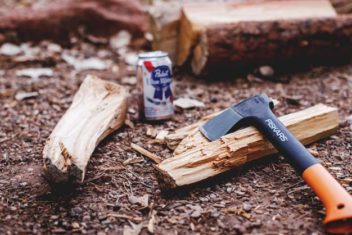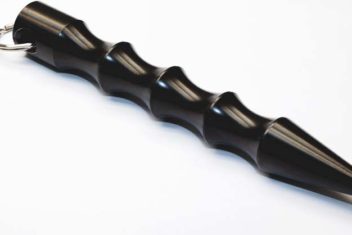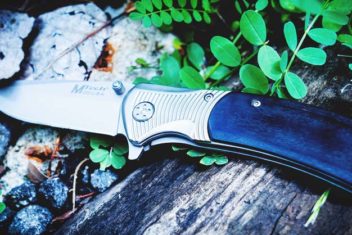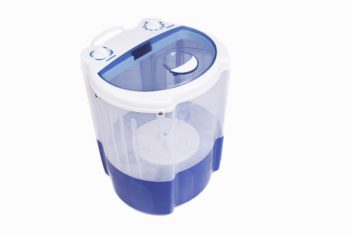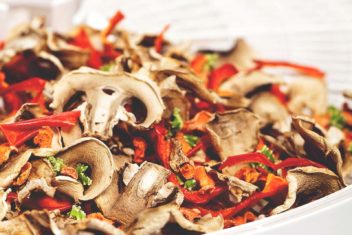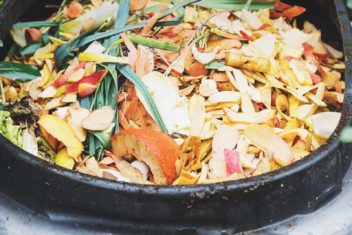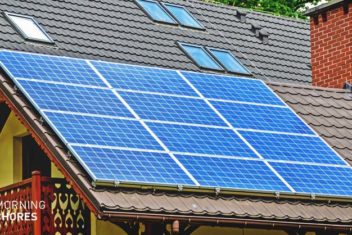If you are an avid gardener, having a well-maintained and healthy green lawn is important. Not only for enhancing the overall look of your property but also to improve the quality of the soil. Whether you are planting a new lawn or looking to re-seed unsightly patches of bare ground, finding the right type of grass seed will help you to get the beautiful lush green lawn you desire.
The 5 Best Grass Seeds
- JRK SEED 4 Fescue Low Grow/No Mow Seed
- DC Earth Creeping Red Fescue
- Jonathan Green Fall Magic Grass Seed
- Scotts Turf Builder Quick Fix Mix
- Pennington Smart Seed Sun and Shade Seeds (Our Top Pick)
Our Top Pick for the Best Grass Seed
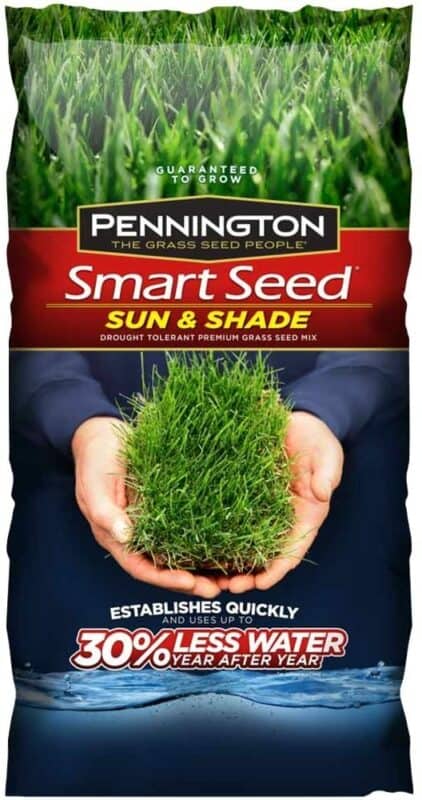
Our top pick for the best grass seed is the Pennington Smart Seed Sun and Shade Seeds.
These super seeds are pretty tough and can survive in almost any kind of climate. Even sandy soil will not stop them from flourishing. The seeds can be planted in full sun or moderate shade. With a quick rate of germination, they will spring to life into a beautiful green lawn.
One of the best aspects of the Pennington Super Seeds is that they are very low maintenance. They also require less watering. This will save you money on your water bill.
Check the price on Amazon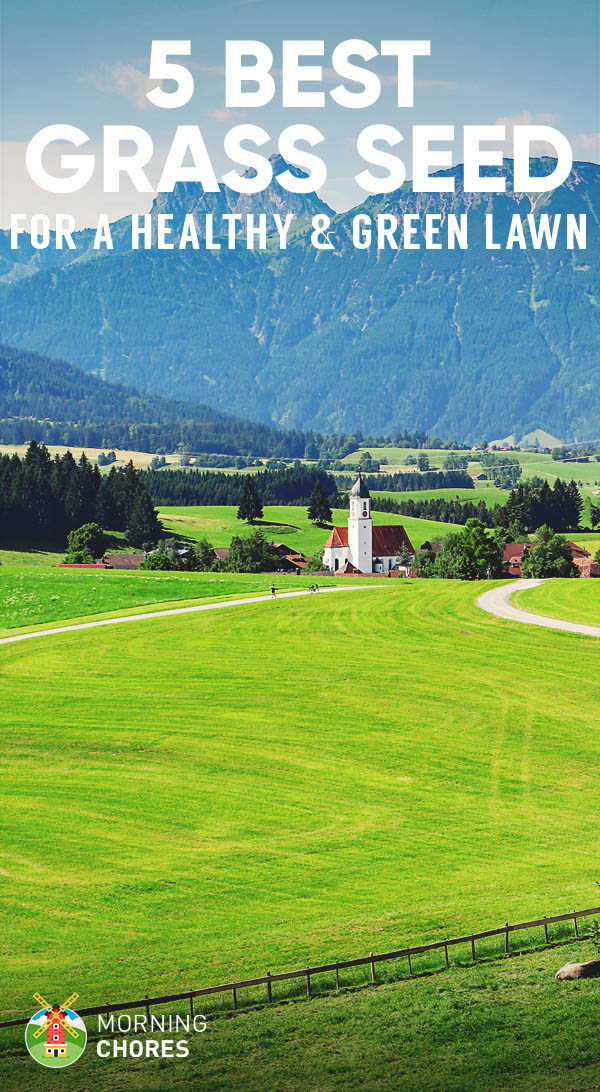
How to Choose the Best Grass Seed for Your Lawn
Your choice of grass seed will depend on what you want to use it for. So to be able to find the right seed for your lawn’s needs, consider these 5 questions:
- Are you planting a new lawn from scratch or do you have bare patches that need to be covered quickly?
- Does your yard have a lot of shade from trees? Or does it receive a lot of sun, partial, or no sun at all?
- Do you prefer a certain variety of grass seeds, such as Red Fescue, or would you prefer a mix of different seed varieties?
- How much time do you have to dedicate to the maintenance of your lawn? Are you “time-poor” and prefer a low maintenance type of grass seed that does not need a lot of watering? If you do not have time to regularly water the lawn, why not choose a grass variety that is drought resistant or has been specifically designed to retain water.
- What type of soil do you have, is it clay-based or sandy soil? What is the pH level of the soil? If you are not sure about your soil type or pH levels, you can always consult your local gardening store for advice. Some grass seed manufacturers will display the type of soil pH or soil type that is right for their particular type of grass mix.
Good to Also Consider
In addition to the above 5 questions, you also need to consider the climate where you live. The types of grass that are best suited to that climate.
Do you live in a warm climate that has a lot of hot sun and experiences periods of drought? Maybe you live in a cooler climate where there is a lot of rain? All of these questions will determine what type of grass seed is the right fit for your lawn.
Some grass types thrive in cooler temperatures, while other types grow faster in a warmer climate. Some grasses prefer a dry arid climate, while others prefer a wet climate.
If you find that your grass is not growing, chances are the grass seed is not suited for your geographic area and its particular climate.
For example, if you live in the US, choosing the right seasonal grass will depend on the particular geographic location or zone in which your state is located.
The US is split into 4 zones:
Cool/Humid Zone
The Cool/Humid Zone contains areas like the Northeast and some of the Midwestern states.
Cool/Arid
The Cool/Arid zone contains some of the drier areas of the Midwest and West.
Warm/Arid
The Warm/Arid zone contains the states in the South-West.
Warm/Humid
The Warm/Humid zone contains states in the South-East and also the Gulf States.
Then there is another geographic area called the transition zone. This zone can be more of a challenge for gardeners to find the right kind of grass seed. The Transition Zone experiences all four of the above climates. Here is a map that shows the particular states that fall into these four zones.
As well as these basic four zones as outlined above you can also access a more detailed map. A Turfgrass Selection Climate Color Coded map, which divides the US into 11 separate planting zones, depending on whether you live in a warm or cool zone.
Once you have found out which geographical or temperature zone your state falls into, you can start looking for the particular grass type that will work best in your area.
Types of Grass Seed
Grass seeds fall into 2 types: cool-season grasses and warm-season grasses.
Cool Season Grass
Cool-season grasses predominately thrive in the cool/humid and cool/arid zones, which are contained in the Northern/Northeast and Midwest sections of the US. These grasses are very hardy and they are a good choice as they can withstand colder temperatures. However, they can also tolerate some heat. They grow the best in temperatures that range from 65-80°F. They should be planted during the spring and fall months.
Some of them can handle long periods of drought as they go dormant and then start to grow again in the cooler months.
Except for the coldest winters, cool-season grasses will continue to grow to a certain extent while they are under snow cover. It is best to plant cool-season grasses in the fall. This is so that they have time to take root before the winter season arrives.
– Examples of Cool Season Grasses
Some popular examples of cool-season grasses include Ryegrass, Kentucky Bluegrass, and Red Fescue.
Kentucky bluegrass is one of the most popular cool-season grasses due to its fine-blade blue-green appearance and general all-around tolerance to a variety of growing conditions.
Ryegrass is another popular cool-season grass that provides excellent cover in high-traffic areas. It is also a very good choice for those gardeners who need to cover bare patches in their lawn quickly, as it has a fast germination rate.
Red Fescue or Creeping Red Fescue is the ideal choice for a garden that has full or partial shade areas with some exposure to the sun. And for gardeners who prefer a low maintenance lawn. Creeping Red Fescue can provide good ground cover all year round. It can also withstand drought conditions and can be used in zones 1-7. And also in areas that have winters that have temperatures that drop to -15°F.
Red Fescue is not ideal for areas that have warmer winters as the lack of freezing winter temperatures does not provide the necessary time for the seeds’ dormancy.
Warm Season Grasses
Warm-season grasses grow well in the summer months. They tend to be very drought-resistant. So they are also ideal for lawns that are situated in the southern states. They thrive in gardens that receive a lot of sun and grow the best in temperatures that range from 75-90°F.
During the cooler seasons around late fall and into the winter months, the grass will become dormant and turn brown and will grow once again when the warmer seasons begin to arrive.
– Examples of Warm Season Grasses
Some popular examples of warm-season grasses include Bermuda, Zoysia, St. Augustine, Bahia, and Buffalo.
Bermuda grass is very durable and requires little maintenance and tolerates drought conditions very well. However, it is not tolerant of shady areas.
Zoysia grass is a low-maintenance grass. It produces a dense growth and can grow in a large variety of soils, from sandy to clay and alkaline to acid. Although it is predominantly found in the Southern States, it has been found in some parts of the north like New York and Chicago.
St. Augustine grass has heat-resistant qualities. It is ideal for humid parts of the Southern and Gulf states. However, it does not tolerate cool temperatures very well.
Bahiagrass does very well in sandy, slightly acidic soils and full sun conditions. It is a low-maintenance turfgrass that requires minimal watering and fertilizing. However, it does not develop the thick, rich look of other grasses. It can withstand a lot of activity. It can also survive short periods of drought but does not handle the cold weather very well.
Buffalo grass is one of the few native kinds of grass in the US. It can be found in the west of the Mississippi, and many semi-arid regions of Texas, and other areas in the southwest. It can withstand near-freezing temperatures for short periods and extended drought periods. However, it does not do very well in high activity areas.
5 Best Grass Seeds – Reviews
1. JRK SEED 4 Fescue Low Grow/No Mow Seed
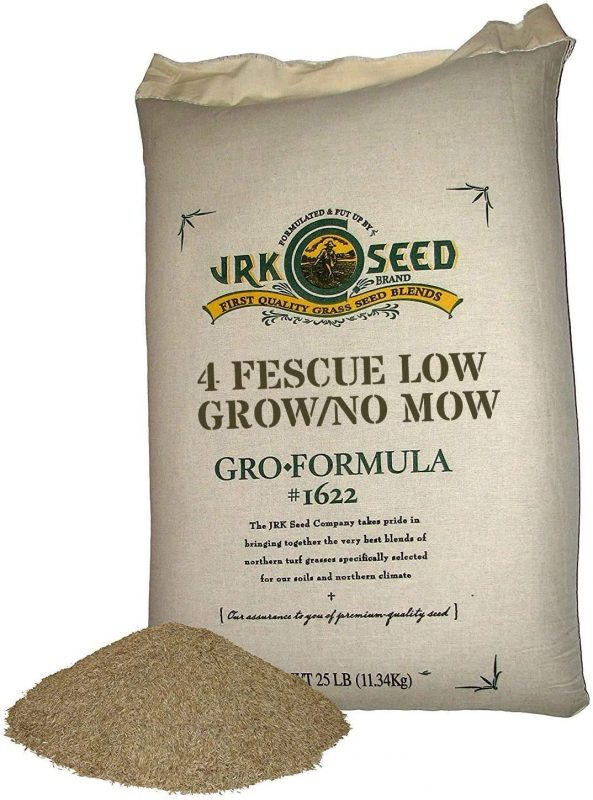
JRK SEED has designed its 4 Fescue Low Grow/No Mow Seed to produce a no-maintenance lawn that will have the best tolerance to drought conditions. Although this 10lbs bag of grass seed contains a blend of Boreal creeping red fescue, VNS Sheep’s Fescue, Reliant IV Hard Fescue, Ambrose Chewing Fescue, and Named Perennial Ryegrass, which have been specifically selected for northern soils and climates, it can also be used in the warmer states.
The best time to plant these seeds is early Spring or early Fall and the seeds will germinate quickly to produce a thick green lawn that has an even coverage over a 1000-square-feet area. As the grass will require minimal maintenance, it is ideal for lawns that host a lot of activity.
To get the best growth rate out of the seeds is to plant them in the bare ground that has been prepared for seeding. You can plant the seed in sandy soil and normal soil, on a flat lawn, a hillside, or a shaded tree line. JRK Seed is fast growing and will result in a healthy lawn that requires little or no mowing depending on fertility and moisture. The grass seed is also available in a 3lbs bag, 5lbs bag, and 25lbs bag.
Pros
- Economical
- Creates a lawn that requires minimal maintenance
- Drought-tolerant
- Grows well in direct sunlight and shaded areas
- Produces thick green grass
Cons
- Pricey
- Lawns in the Pacific Northwest may require more mowing due to higher levels of rainfall
2. DC Earth Creeping Red Fescue
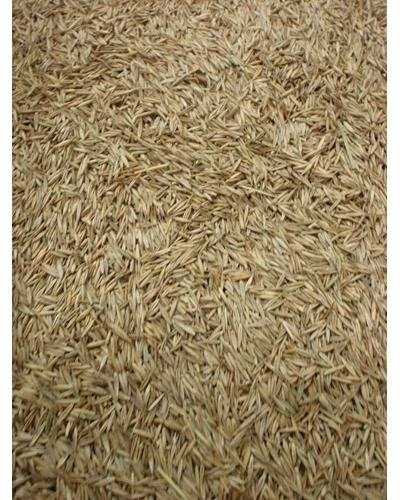
DC Earth Creeping Red Fescue is the ideal choice for a garden that has full or partial shade areas with some exposure to the sun, and for gardeners who prefer a low maintenance lawn. Creeping Red Fescue is a hardy type of grass that can provide good ground cover all year round and can withstand drought conditions.
It can be used in zones 1-7, and in areas that have winter temperatures of -15°F. These seeds are not ideal for zones 9-11 that have warmer winters as the lack of freezing winter temperatures does not provide the necessary time for the seeds’ dormancy.
DC Earth grass seeds can help with erosion control and will attract wildlife to your lawn or meadow. The seeds are very hardy and can be planted in well-drained, dry, or average soil. They can tolerate soil types such as sandy, loamy, acidic, and dry soil.
To get the best results, the seeds need to be planted in the cooler months. They should start to bring forth rich green shoots in mid-summer, and once the grass reaches its maturity, it will provide even coverage of 90-150lbs per acre and grow up to 12-24-inches in height.
Pros
- Ideal for full or partial shade areas with some exposure to the sun
- High rate of germination
- Provides very good coverage
- Drought-tolerant
- Creates a beautiful lush green lawn
Cons
- Not ideal for full sun areas
3. Jonathan Green Fall Magic Grass Seed
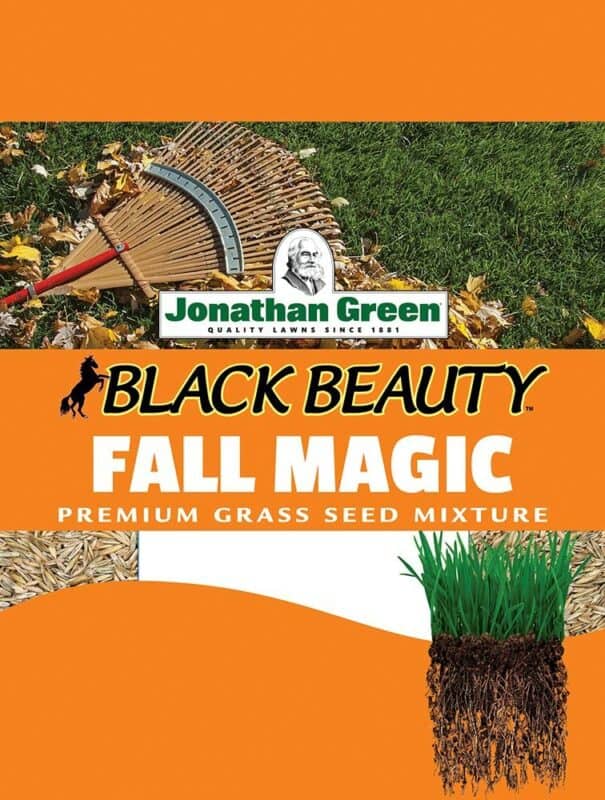
The Jonathan Green Fall Magic Grass Seed is a good choice if you need to cover any unsightly bare patches of soil. Or if you want to start a new small to medium-sized lawn. The seed mix is also ideal for those lawns that have been summer damaged or have been ravaged by insects as the seed is engineered to be disease and insect-resistant.
The fall magic mixture is specially formulated for seeding in late summer to early fall. As the seed mix contains ryegrass, bluegrass, and creeping red fescue, the seeds have an all-around tolerance to a variety of growing conditions. To get the fastest germination rate, the seeds should be planted in well-moisturized soil that has a pH level of 6.5-6.8.
You can plant the seeds in a sunny or shady area, and the 3lbs mixture will cover up to 1500-square-feet and will grow into an attractive green lawn.
Although the seeds are drought resistant and are capable of preserving moisture when they are fully grown, it is recommended that you carefully follow the product’s instructions to give your lawn the best start in life.
Pros
- Good value for money
- Fast germination
- Ideal for sunny or shady areas
- Ideal for covering bare patches
- Attractive dark green lawn
Cons
- Need to buy more bags for a large sized lawn
4. Scotts Turf Builder Quick Fix Mix
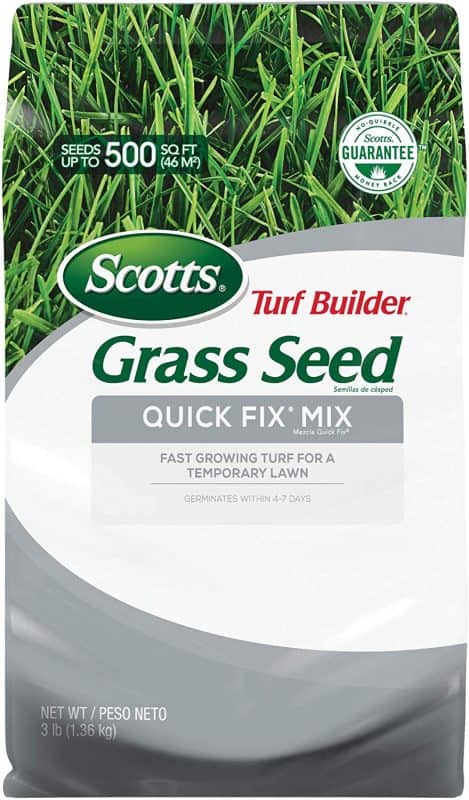
If you need to cover those bare spots in your garden, or just need some fast-growing turf, Scotts Turf Builder Quick Fix Mix is a great choice. This weed-free mix can be used in shady or sunny areas in well-aerated soil and will provide good, even ground cover for up to 500-square-feet.
Scotts Turf Builder has been specially designed for use in the Northern States and as it contains perennial ryegrass, seeds that grow best when temperatures are between 60-80°F.
With its fast germination rate, you will start to see the first rich green blades emerge in about a week for small areas. And up to 2 weeks for larger areas of your lawn. Scotts Turf Builder is specially designed for covering bare spots on your lawn. However, if you want the mix to cover a larger area of your lawn, you will need to spread the seeds evenly and regularly water the seeds in the early stages of germination.
If you want to use the mix to kick-start a brand new lawn for a small to medium-sized area, you will need to purchase additional bags of seeds.
Pros
- Good value for money
- Ideal for sunny or shady areas
- Quick germination rate
- Ideal for covering bare patches of lawn
- Good coverage and erosion control
- 99.9% weed-free
- Creates a rich green lawn
Cons
- Not ideal for planting a large lawn
5. Pennington Smart Seed Sun and Shade Seeds

The Pennington Smart Seed Sun and Shade Seeds are one of the top-selling grass seed products in the Northern States of the US. It is a very versatile seed mix that is engineered to be drought, heat, and disease resistant. It can survive in almost any type of climate and soil type, so you could also use it if you live in the southern states.
The secret to its success is the Myco Advantage technology, which helps to create a dense root system that allows the grass to retain water to endure drought and tough summer heat. Pennington’s Penkoted technology also protects the seed from deadly fungus by enabling the seed to establish itself faster during the early stages of germination, when it is most susceptible to the ravages of disease.
This pure-bred premium smart seed mix contains cool-season grasses such as Tall Fescue, Red Fescue, and Kentucky Bluegrass, which will thrive in those sunny areas of your garden that receives from 4-8 hours of sun per day. However, it also grows very well in moderately shady areas.
The 7lbs bag of seeds can cover up to 2300-square-feet and with a quick 7-14 day seed germination period, you will be the proud host of a beautiful dark blue-green fine-bladed lawn.
The grass is low maintenance and does not require a lot of watering, which can save you up to 30% more water year after year.
Pros
- Very good rate of germination
- Drought, heat, and disease resistant
- Ideal for sunny and shady areas
- Attractive bright green lawn
- Low maintenance
- Economical
Cons
- Expensive
Our Top Pick for the Best Grass Seed

Our top pick for the best grass seed is the Pennington Smart Seed Sun and Shade Seeds.
These super seeds are pretty tough and can survive in almost any kind of climate. Even sandy soil will not stop them from flourishing. The seeds can be planted in full sun or moderate shade. With a quick rate of germination, they will spring to life into a beautiful green lawn.
One of the best aspects of the Pennington Super Seeds is that they are very low maintenance. They also require less watering. This will save you money on your water bill.
Check the price on Amazon